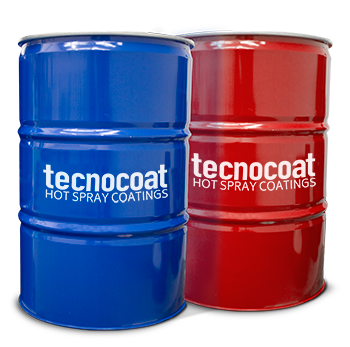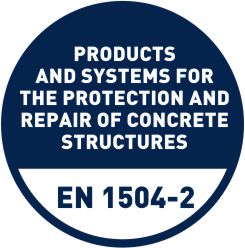GENERAL SPECIFICATIONS
- Two component, 100% solids content, aromatic highly expandable pure polyurea that once applied, forms a continuous, seamless, waterproofing, and solid membrane that offers a waterproofing, and watertight behavior to be applied in irregular substratas as concrete, metal roofs or asbestos
- Once applied offers also a thermal isolation behavior
- The application and training is done by our spray equipment TC2049 (spray-equipment.tecnopolgroup.com) or similar
- It has CE marking on the basis of a statement made DoP Declaration of Performance (DoP) conforms to the regulations UE305/2011.
- Thanks to its versatility and its drying time approx. 10 seconds allows the adherence to any surface, making it the ideal product for application on uneven surfaces and in areas of any shape, whether curved or squared.
- Joints and any type of union are saved since the finish is uniform and in one piece, providing a surface with optimal maintenance and cleaning.
- Has properties to allow it to adhere to most surfaces such as concrete, ceramic tiles, metals, plywood(OSB), asphalt/bituminous sheets. In any case or material, the surface must be consistent and sound (concrete pull-off strength >1.5 MPa), clean, and dry when the products are applied. Recommended applying directly on the concrete deck.
- Free from harmful VOC compounds, therefore, it does not hurt the ozone layer (VOC's zero). It's 100% recyclable by mechanical means friendly to the environment; no gas collection for recycling and/or destruction is required; it doesn´t emit substance to the environment once installed..
- It should be applied in dry conditions avoiding the presence of humidity or coming from the surface to be coated or the substrate, whether at the time of application or subsequently (pressure from phreatic water level). In the event there is humidity in the substrate at the time of application.
- It is an aromatic membrane and, even though it is stable against solar radiation it requires solar radiation protection (UV rays) to do not lose its physical and mechanical properties. Therefore, this system needs a protective polyurethane colored aliphatic resin, Tecnotop 2C, for use in the absence of other physical protection elements. You can apply Tecnotop S-3000, Tecnotop 2CP or Tecnotop 1C also.
YIELD
The recommended minimum thickness is 10 mm. (400 mils DFT), total yiedl is 2 kg/sqm, applied in various coats.The total thickness may vary according to substrate or climatological conditions.
PACKAGING
Metal drums of 225 kg each component (B side: amines and A side: isocyanates).
STORAGE AND SHELF LIFE
12-months shelf life is stored in original containers in a dry environment at a temperature between 5-35 ºC (41-95°F). Keep away from direct sunlight, extreme heat, cold or moisture. Prior to application, B side must be thoroughly mixed with a drum mixer before inserting the transfer pumps and use. This step is very important, please consult your representative for recommendations.
APPLICATION METHOD
Concrete/mortar substrate: Concrete should be completely cured (concrete curing takes 28 days) or, in any case, the maximum level of humidity allowed for the substrate should be verified, depending on the primer used. Concrete must be strong, cohesive and dry, having a correct planimetry, high surface resistance, eliminating laitance, graise, oils or release agents, without excessive irregularities. Therefore, the previous action of sanding, polishing, milling or shot-blasting will be assessed by the applicator to achieve a preparation of the substrate according to ICRI Guide 03732, CSP values 3 to 5. Existing holes or areas with a lack of material must be repaired using some of our epoxy resins: Primer EP-1020/Primer EP-1010. Mastic PU must be used on fissures or small cracks on the surface. In joints: remove old material, clean and fill with Mastic PU. Complement with a Tecnoband 100 band on the upper part. In structural/expansion joints: remove old material, clean and fill with Mastic PU. Complement with specific elastic bands and Tecnoband 100. General cleaning of the substrate. PRIMING: use Primer PU-1050/Primer PUc-1050, Primer EP-1020, Primer EP-1010 or Primer WET, depending on the existing moisture in the substrate. Apply/spray the membrane evenly and in several layers until the dry film thickness required by the project is achieved. Application of the aliphatic polyurethane resin for protection against UV rays Tecnotop 2C/2CP/1C.
NOTE: For other types of substrates, weather conditions or the substrate to be applied, consult our technical department.
APPLICATION REQUIREMENTS (proportioner)
It is necessary to mix the two initial liquid components using a high-pressure plural component proportioner; isocyanates and amines must be mixed 1:1 in volume using our spray equipment TC2049 (spray-equipment.tecnopolgroup.com) or similar (proper maintenance and cleaning it is recommended). The general parameters for material area as follows:
- Isocyanate heater temperature: 65-68 ºC (149ºF to 155ºF)
- Amine heater temperature: 68-73ºC (153ºF to 163ºF)
- Hose temperature ±65ºC (149ºF)
- Working pressure: 2,500 to 3,000 psi (172 to 205 bar)
- Recommended mixing chamber: GU-07008-1
These temperatures and pressure parameters must be valued, ratified or slightly varied by the applicator, depending on the conditions of each climatic zone, weather situation or according to the specifications of the projection equipment. It is the responsibility of the owner / applicator of the equipment to keep it in perfect condition in order to maintain the correct mixing ratio of the two components that Tecnopol delivers separately, by periodically updating its maintenance controls. During the execution of the application, it may be necessary to correct these parameters according to changing external conditions, as well as to verify the correct operation of the machine (pressure and temperature). The part B must be thoroughly mixed with an mechanical mixer before inserting transfer pumps. Isocyanate are sensitive to moisture, ensure the drums and spray equipment are protected from moisture during storage and application. Store and clean proportioner by manufacturer’s suggested guidelines.
HEALTH AND SAFETY
Respiratory Protection: When handling or spraying use an air-purifying respirator. Skin protection: Use rubber gloves, remove immediately after contamination. Wear clean body-covering. Wash thoroughly with soap and water after work and before eating, drinking, or smoking. Eye / Face: Wear safety goggles to prevent splashing and exposure to particles in the air. Waste: Waste generation should be avoided or minimized. Incinerate under controlled conditions in accordance with local laws and national regulations. Re-occupancy of the work site without respiratory equipment is minimum 24 hours providing the correct ventilation for the area sprayed. Contractors and applicators must comply with all applicable and appropriate guidelines for storage and safety guidelines.These safety recommendations for handling, are necessary for the implementation process as well as in the pre and post, on exposure to the loading machinery. Dispose waste in accordance with star or/and local regulations.
TECHNICAL AND CHEMICAL PROPERTIES
|
PROPERTIES
|
RESULTS
|
|
Density ISO 1675
|
±0.25 g/cm³
|
| Density compounds* A/B ISO 1675 |
1.11 ±0.05 g/cm³ / 1.10 ±0.05 g/cm³ |
| Viscosity (at 12 rpm) ISO 2555 |
850±50 cps / 950±50 cps |
| Mixing ratio (per weight-per volume) |
100/102 - 100/100 |
| Tack-free time / recoat time |
±10 secs / 10 secs~ 48 hours |
| Use temperature range (environment) |
-20~ 80 ºC (-4 to 176ºF) |
| Application temperature range (substrate / environment) |
5 ~ 35 ºC (41 to 95ºF) |
| Maximum environmental humidity |
±85% |
|
Elongation at break ISO 527-3
|
>180%
|
|
Tensile strength ISO 527-3
|
±2 MPa
|
|
Hardness Shore A DIN 53.505
|
>50
|
| Solid content ISO 1768 |
100% |
| VOC content |
0 |
| Watertight EN1928:2000 Method A |
PASS |
| Thermal conductivity EN 12667:2002 |
0.081W/mK |
| Thermal resistance EN 12667: 2002 |
0.74 sqm* K/W
|
| Roof slope |
zero slope, ponding water admitted |
| Fire reaction EN-13501 |
Euroclass E |
| Abrasion resistance (Taber) EN ISO 5470-1 |
970 mg (weight loss <3.000mg) |
| Carbon dioxide (CO2) permeability EN 1062-6 |
36.7 g/sqm*day |
| Diffusion-equivalent air layer thickness EN 1062-6 |
S d= 6.8m |
| Diffusion resistance number EN 1062-6 |
µ= 841 |
| Determination of crack bridging properties UNE-EN 1062-7 Static Method |
Class A5 (-10ºC) |
| Determination of crack bridging properties UNE-EN 1062-7 Dynamic Method |
Class B.3.2 (23ºC) |
| Determination of liquid water permeability, EN 1062-3 |
< 0.015 kg/sqm*h0.5 |
| Bond strength by pull-off EN 1542 |
0.8 MPa |
| Falling-weight test EN ISO 6272-1 |
24.5 Nm (Class III) |
| Diffusion-equivalent air layer thickness EN ISO 7783 |
Sd<0.2m (Class I) |
| Water-vapor resistance factor EN ISO 7783 |
µ= 23 |
| Water-vapor transmission rate EN ISO 7783 |
V= 115.5 g/sqm*day |
Results were performed in the laboratory at 23ºC (73ºF)and 50% RH, under controllable conditions. These values may vary depending on the application, climatology, or substrate conditions.
* Data for component B pigmented in black For other colorations or neutral, consult the official COA issued by Tecnopol (Certificate of Analysis for each batch delivered). Results were performed in the laboratory at 23ºC and 50% RH, under controllable conditions.










